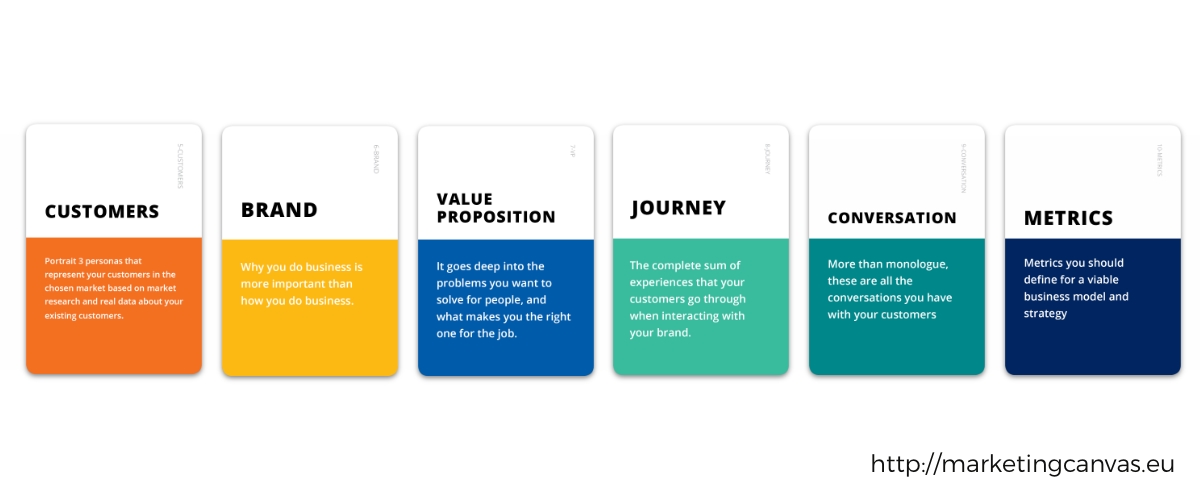MARKETING CANVAS STRUCTURE
As said by Philip Kotler: “Marketing is the science and art of exploring, creating, and delivering value to satisfy the needs of a target market at a profit”. While the first part for the definition remains true in essence, the world has evolved and challenges of the past are no more the challenges of today. Therefore one of the question we can have is: How can we explore, create and deliver value today in a digital world? Or differently said: “Which process should we follow for exploring, creating and delivering value today?”.
The Marketing Canvas method is a powerful tool for exploring, creating, and delivering value to your target market, particularly in the digital world we inhabit today. This model contains 1 context dimension, 1 goal dimension and six meta-dimensions, each with four sub-dimensions, to capture the intricacies of your marketing strategy.
Let's delve into each of these six meta-dimensions and twenty-four sub-dimensions:
1. Customers: This meta-dimension signals a shift from traditional product-centric marketing (part of the 4P model) to a more human, or customer-centric approach. It aligns with the principles of user-centered design propagated by Alan Cooper. It includes:
Job to be Done: Reflecting the principles of Clayton M. Christensen's Jobs to Be Done theory, this assesses the problem your product or service solves for the customer.
Aspirations: This measures the alignment of your product or service with the customer's personal goals and dreams.
Pains/Gains: This echoes Alexander Osterwalder's Value Proposition Canvas, focusing on the customer's struggles and how your product alleviates them, or the benefits they gain from using your product.
Engagement: This measures the level of interaction between your brand and its audience, highlighting the importance of creating strong customer relationships.
2. Brand: This meta-dimension underscores the importance of brand in marketing, a concept not explicitly covered by the 4P model. It includes:
Purpose: This reflects Simon Sinek's "Start With Why" theory, focusing on your brand's mission or reason for being.
Positioning: This relates to how your brand differentiates itself from competitors, an idea expanded on by thought leaders like Jack Trout and Al Ries.
Values: These are the principles that guide your brand's actions, forming part of your brand's unique personality.
Identity: This encompasses the visual and verbal elements that represent your brand, a concept emphasized by marketing guru David Aaker.
3. Value Proposition: Borrowed from Alexander Osterwalder's Business Model Canvas, this meta-dimension defines why customers should choose your product over others. It includes:
Features: These are the functional aspects of your product that address the job to be done.
Emotions: This recognizes that emotion is a significant driver of purchasing decisions, a concept championed by scholars like Gerald Zaltman.
Prices: This aligns with the 'Price' in the traditional 4P model, but considers pricing relative to value offered and competition.
Proofs: These are validations of your value proposition, like testimonials, case studies, or ratings and reviews.
4. Journey: This meta-dimension replaces the traditional 'Place' concept from the 4Ps and embraces the entirety of the customer's interaction with your brand. It echoes the concept of 'Customer Journey Maps' prevalent in UX design. It includes:
Moments: These are the significant touchpoints a customer has with your brand.
Experience: This reflects the overall impression that customers get from interacting with your brand, a key concept in the field of Customer Experience (CX) management.
Channels: This expands the 'Place' concept of the 4Ps, considering all mediums of customer engagement.
Magic: These are the memorable, delightful moments that surprise and exceed customer expectations, often referred to as 'delight factors' in experiential marketing.
5. Conversation: This meta-dimension replaces traditional 'Promotion' strategies with a focus on meaningful dialogues with customers, aligning with the paradigm shift towards 'Conversational Marketing'. It includes:
Listening: This echoes the importance of customer feedback, an idea advocated by thought leaders like Jay Baer. It's about understanding and responding to customer needs and concerns.
Content & Stories: This underscores the shift from traditional advertising to storytelling, an idea championed by Seth Godin and other marketing leaders. It's about the narratives your brand shares to engage and resonate with your audience.
Media: This expands upon 'Promotion' in the 4P model, considering all platforms or channels used to deliver your content and engage with your audience.
Influencers: This reflects the recent rise of influencer marketing as a key promotional strategy, recognizing people who can promote your brand to their audience.
6. Metrics: This meta-dimension connects your marketing strategy with your performance indicators. It's about monitoring the success of your marketing activities and ensuring alignment with business objectives. It includes:
User: This metric, often emphasized in digital marketing and growth hacking strategies, refers to the number of people actively using your product or service.
ARPU (Average Revenue Per User): This metric, common in subscription-based businesses, represents the average revenue generated per user during a specific period.
Lifetime: Also known as "Customer Lifetime Value" (CLV), this metric is advocated by marketing scholars like Philip Kotler. It estimates the total revenue you can expect from a customer during their entire relationship with your business.
Budget: This connects with the financial aspect of marketing strategies, focusing on the total money allocated for marketing activities. It's about financial efficiency, monitoring the return on investment (ROI) of your marketing efforts.
By comparing the Marketing Canvas method to traditional models like the 4Ps and referencing influential thinkers in the field, we can better understand its holistic and customer-centric approach. This method provides a comprehensive framework to explore every aspect of your marketing plan, from understanding your customers to measuring your success.
Marketing Canvas














